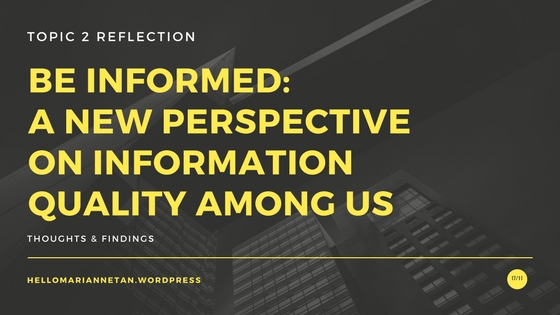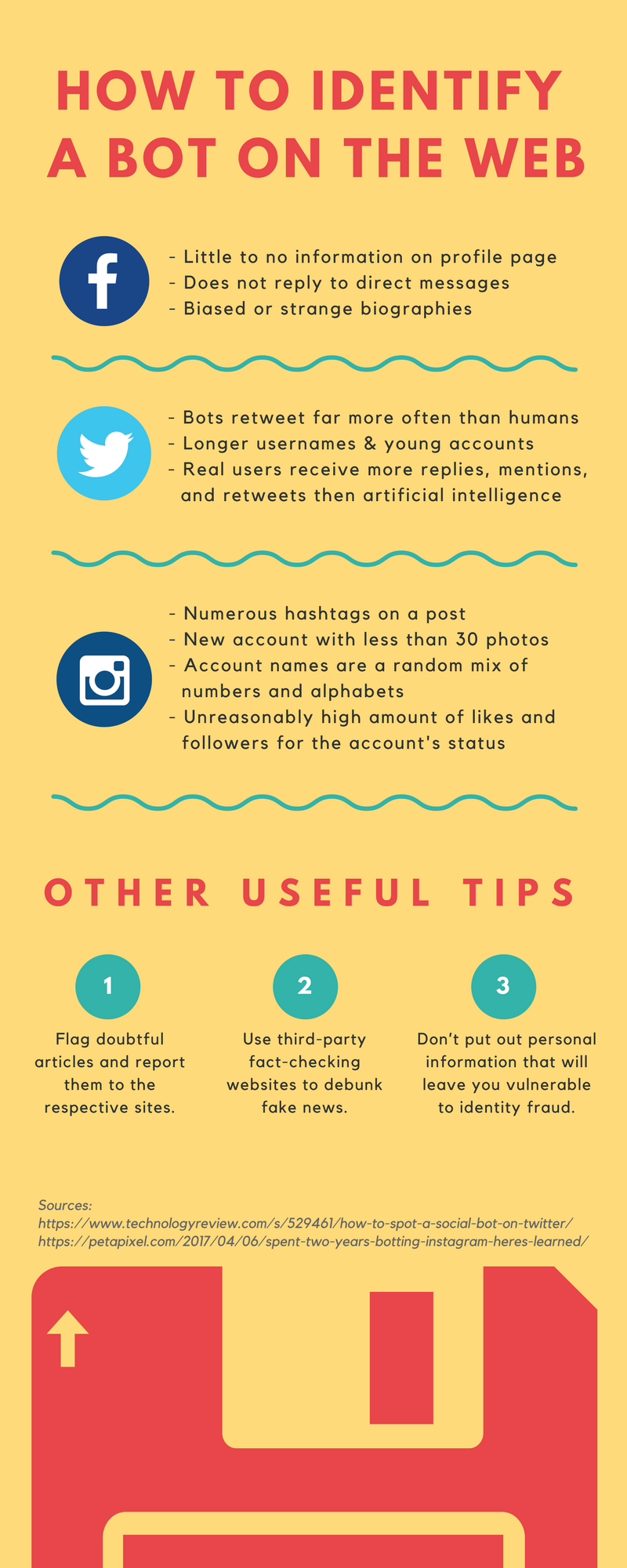
Source: made on Canva
My thoughts on information quality have changed during the past few sessions and I have learnt a great deal about fake-news. Whether we are digital natives or visitors, it is crucial for us to be aware of our own filter bubbles. The existence of bots on Social Media could potentially have an impact on influencing public’s perception at a global level.
I agree with Alicia’s post about the creation of fake-news which “ boils down to one’s character to create/distribute wrong information.” An example she mentioned was the Las Vegas Shooting where information was rapidly being shared on Social Media, regardless of it’s factual or satirical nature.

Source: made on Canva, content by (French, 2016)
Although third-party fact-checkers, like Snopes, are available, more can be done towards the removal of fake-news by implementing stricter rules within Networking sites, but could this impact their profitability? Networking sites gain from fake-news as it increases the company’s revenue from page views and advertising.
I can relate towards Nicholas’s post that “it is crucial that we widen our networks and research widely” so that we aren’t stagnant in our own echo chamber. It was also insightful to read about the credibility of influencer’s post on Social Media as digitally-doctored photos can be manipulative and even pose as “evidence” supporting fake-news.

Source: made on Canva, content by (Wan, 2017)
The fake-news ecosystem is growing more political and vastly influential, it was seen that Donald Trump’s campaign manager tweeted links to fake-news, which appeared in the news on Google (Dewey, 2016). Fake-news may have affected the 2016 US Presidential election and this only emphasizes the importance of fact-checking sources.

Source: Paul Horner, owner of the fake-news empire and responsible for the satire news about the 2016 presidential election
As mentioned in Jian Wen’s post, Singapore is also susceptible to fake-news such as the IKEA scam that was circulated around the Internet and instant messaging apps. The intention of this scam is to steal the user’s personal information that could make them vulnerable to identity thief (Surane, 2017).
In conclusion, we can’t identify a malicious bot at first glance as bots are getting more sophisticated and significantly harder to spot (bots hacking into real accounts, humans lending bots their account, etc.) (Brandom, 2017). We can however, start by spreading the awareness of bots, fact-checking the source and being unbiased toward a post through critically analyzing a post, might prevent an unbiased outcome.

Source: original content
(Word count: 317)
Comments:
Alicia’s Blog
Nicholas’s Blog
References:
French, 2016. This person makes $10,000 a month writing fake news (online). Retrieved from: https://www.marketwatch.com/story/this-person-makes-10000-a-month-writing-fake-news-2016-11-17
Wan, 2017. Many people can’t tell when photos are fake. Can you? (online). Retrieved from: https://www.washingtonpost.com/news/speaking-of-science/wp/2017/07/17/many-people-cant-tell-when-photos-are-fake-can-you/?tid=ss_tw&utm_term=.2dc9fcf2a72c
Dewey, 2016. Facebook fake-news writer: ‘I think Donald Trump is in the White House because of me’ (online). Retrieved from: https://www.washingtonpost.com/news/the-intersect/wp/2016/11/17/facebook-fake-news-writer-i-think-donald-trump-is-in-the-white-house-because-of-me/?tid=a_inl&utm_term=.dfae318eb4f7
Surane, 2017. Scammers Are Constructing Fake People to Get Real Credit Cards (online). Retrieved from: https://www.bloomberg.com/news/articles/2017-09-12/scammers-are-constructing-fake-people-to-get-real-credit-cards
Brandom, 2017. How to Spot a Twitter bot (online). Retrieved from: https://www.theverge.com/2017/8/13/16125852/identify-twitter-bot-botometer-spambot-program





 A functioning democracy only works with a good flow of objective information, yet Social Media increases polarising segregation that only benefits the user’s ideology. This can become disastrous when consumers receive fake news that manipulates their opinion.
A functioning democracy only works with a good flow of objective information, yet Social Media increases polarising segregation that only benefits the user’s ideology. This can become disastrous when consumers receive fake news that manipulates their opinion.